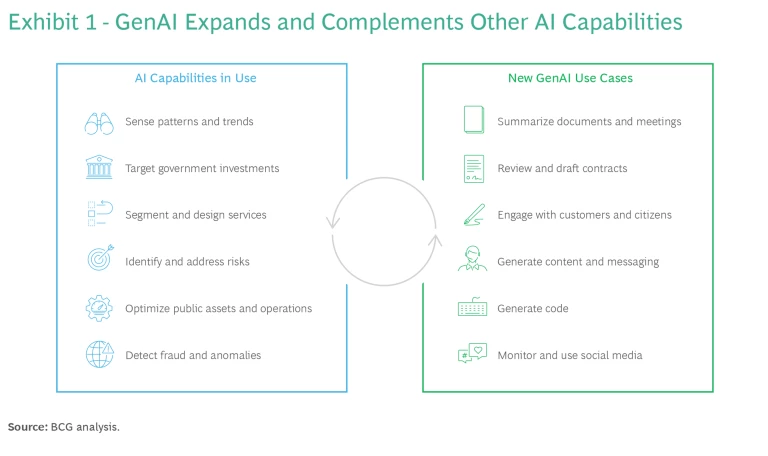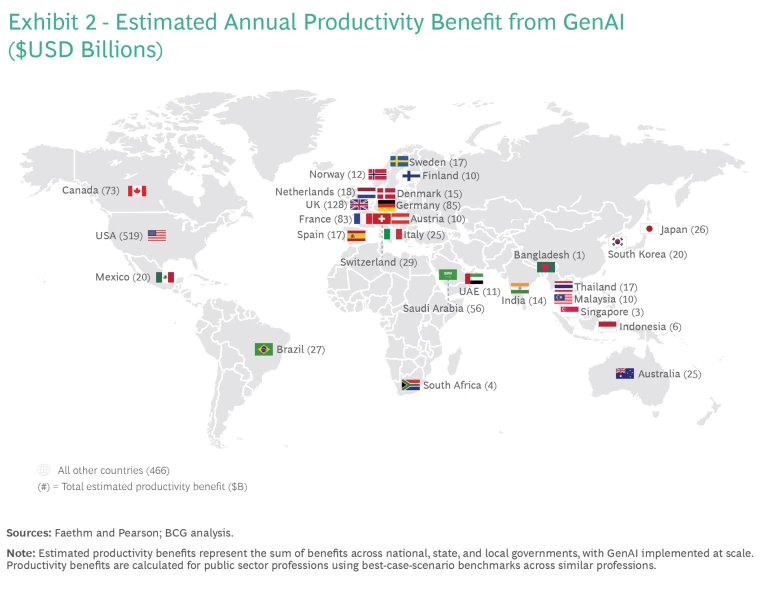The new tools of generative artificial intelligence (GenAI) are fundamentally changing the nature of knowledge work, creating promising opportunities to significantly increase productivity and spur innovation across entire economies. Public administration is one sector where GenAI could have the greatest potential. To reap the benefits of the technology, public sector leaders need to start by understanding how GenAI can create value for them. Then they should set priorities and mobilize to capture its transformative impact.
Generative AI refers to a category of artificial intelligence capable of creating credible new content, including text, images, audio, code, data, and other media, based on foundational or generative models. The most powerful GenAI tools are trained on large language models (LLMs) that process a vast quantity of data to emulate the way people communicate. This capability makes GenAI a general-purpose disruptive technology. It expands the boundaries of what organizations can do in everyday operations, especially in the realm of knowledge work. ChatGPT, one of the first GenAI models for processing language, has more than 180 million users. The market for generative AI products and services is growing exponentially. Since the consortium OpenAI first announced its language model GPT3 in 2020, GenAI has attracted more than $20 billion in venture capital funding. A recent report by Bloomberg Intelligence predicts the market will grow by over 40% per year for the next ten years.

The use of GenAI offers significant potential productivity gains for the public sector. It can improve the quality and speed of government decision-making at scale and raise the efficiency and effectiveness of public policies, programs, and services. The new GenAI tools complement existing AI capabilities already used in the public sector. (See Exhibit 1.)
Currently, most governments are just beginning to experiment with the technology. The conditions are not yet in place to leverage GenAI at scale and unlock its potential. There are also a number of risks related to issues such as accuracy, security, privacy, bias, and intellectual property ownership that need to be managed before fully deploying the technology. This article is the first in a three-part BCG series exploring how governments can responsibly leverage GenAI to drive maximum public impact, how they can
scale the technology
, and how to assess and mitigate the risks.
Productivity Value of GenAI for Governments Estimated at $1.75T
GenAI provides an unprecedented opportunity for governments around the world to deliver greater value and public impact for citizens, businesses, and government. At a minimum, these tools could free up many valuable hours of a public servant’s time on simple and repetitive cognitive tasks and enable that individual to focus on other, higher-value activities.
BCG estimates the productivity gains of GenAI for the public sector will be valued at $1.75 trillion per year by 2033. (See Exhibit 2.) Our estimate on the impact of GenAI is based on using inputs from Pearson-Faethm modeling. It reflects productivity gains across all national, state or provincial, and local governments and across all domains such as legislative, administrative, courts, health care, education, transportation, and security.
The impact of GenAI on public sector jobs is more nuanced. While some efficiencies may lead to reduced need for labor, in most cases governments will seek to reinvest the productivity benefit to address unmet needs of citizens or in higher value-added activities that will generate better outcomes. Some employees will be readily able to adapt and incorporate higher-value work into their role; however, for many workers, reskilling and upskilling will be essential.

Five Opportunities for Government
Given that the nature of opportunities varies across government, we have found it helpful to consider the use cases for GenAI from the perspective of senior executives in five different types of government functions. The range of opportunities and the types of changes that may occur at each level are outlined below, followed by more detailed discussion and use case examples.
- Policy and Programs. To better understand current public policy issues and challenges, as well as the current state and root causes, and to design more effective policy options, interventions, and programs; optimize policy settings; and strengthen deliberative processes.
- Service Delivery and Operations. To improve the quality and accessibility of public services to citizens and businesses, improve efficiency of operations, reduce risks, and continuously optimize allocation of resources to meet policy goals and objectives.
- Support Functions. To improve the efficiency of support functions, shared services, and corporate services; reduce overheads; and improve staff experience.
- Regulators. To improve integrity and compliance with regulations, reduce the cost of monitoring and oversight, reduce risks, streamline administration, and make it easier for citizens, businesses, and other stakeholders to comply and meet their obligations.
- Central Agencies. To develop, implement, and optimize whole-of-government strategies, priorities, policies, and standards, and to optimize funding and resource allocation to achieve government objectives.
Policy and Programs
Expanded capabilities for policy development
Stewardship of how a country serves its citizens requires great skill and involves the continuous optimization of policy and programs.
GenAI
provides new tools for improving the capabilities needed in policy functions, including problem identification and analysis, policy research and synthesis, policy and program design, consultation and stakeholder engagement, and implementation and evaluation.
- Enhanced policy and program design. GenAI tools make it possible for policy analysts to rapidly synthesize and analyze immense volumes of structured and unstructured data from diverse sources and formats and across jurisdictions. These may include past policy documents, speeches, reports and reviews, white papers, academic studies, journals, articles, budget papers, databases and datasets, and other research inputs. GenAI tools can help to summarize issues, identify options, present pros and cons, distill and categorize key points, and draft policy briefs and summaries. This allows policy professionals to provide more timely and responsive advice, cover more ground in their research, strengthen the breadth and depth of evidence that underpins policy advice, and devote more time to critical thinking about more complex policy challenges—adapting and tailoring to the local context, communication, and messaging, implementation considerations, and more intensive stakeholder management.
- Richer public consultation and participatory governance. GenAI can ingest hundreds or even thousands of submissions received as part of public consultation processes, summarize and categorize recommendations and suggestions, create heatmaps to identify areas of alignment and divergence, identify consensus views and unique perspectives, and co-pilot the drafting of summaries and recommendations. This enables governments to gather and process a broader range of inputs, to capture a more extensive and comprehensive range of views from citizens and stakeholders, and to increase transparency and engagement in policy formulation and co-creation. It makes it possible for a wider range of people to engage in and provide perspectives beyond the traditional lobby groups and associations with resources and funding to do so. It enables constituent and stakeholder engagement to occur more frequently, iteratively, and interactively, supporting richer and more substantive conversations to occur.
- More responsive implementation. Policy professionals can use GenAI tools to more rapidly translate new and updated policy into operational changes. For example, when a policy is updated, GenAI tools could be used to generate and update conforming policy and program guidelines; generate computer code and implement the necessary changes in IT systems; rework operational manuals, procedures, and protocols for customer service; and revise government websites—all at once.


















